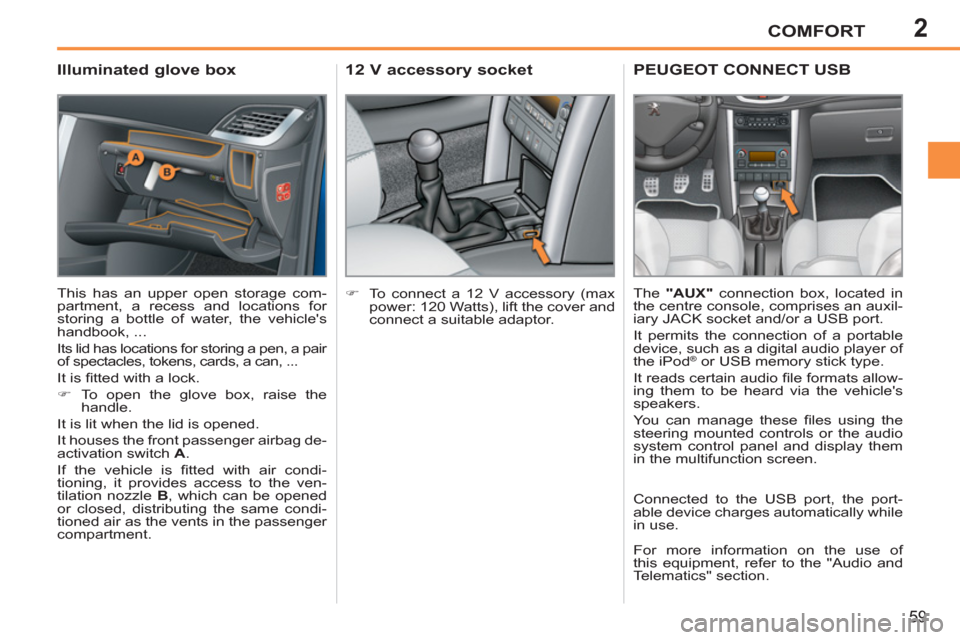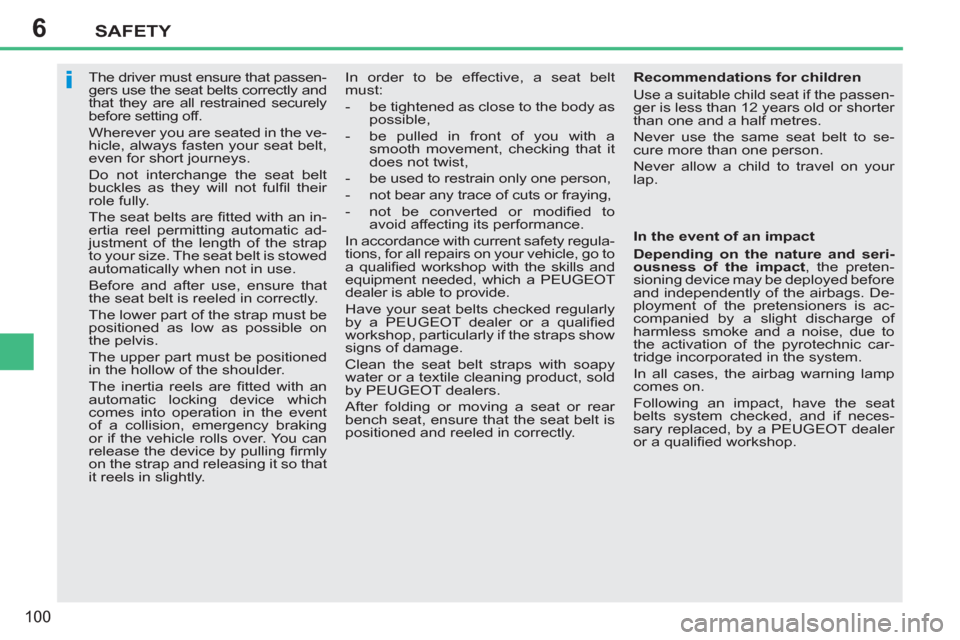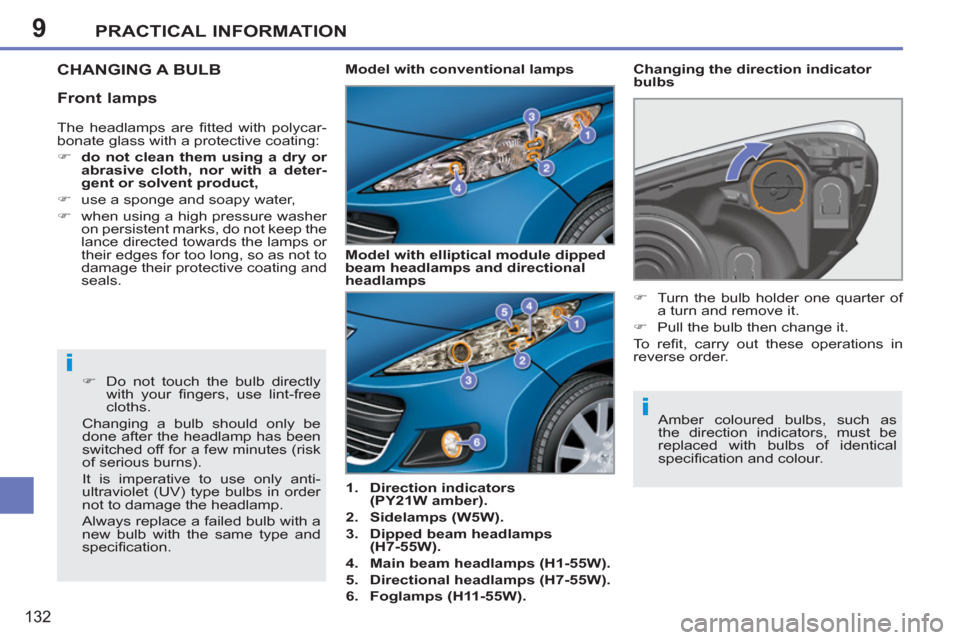2012 Peugeot 207 CC water
[x] Cancel search: waterPage 29 of 224

1INSTRUMENTS and CONTROLS
Warning lamp
is on
Cause
Action/Observations
Airbags
temporarily. This lamp comes on for a
few seconds when you turn
on the ignition, then goes
off. This lamp should go off when the engine is
started.
If it does not go off, contact a PEUGEOT dealer
or a qualifi ed workshop.
fi xed. One of the airbag or seat
belt pretensioner systems
has a fault. Have it checked by a PEUGEOT dealer or a
qualifi ed workshop.
Seat belt not
fastened/
unfastened
fi xed then
fl ashing
accompanied
by an
increasing
audible signal. The driver and/or the front
passenger has not fastened
or has unfastened their seat
belt. Pull the strap then insert the tongue in the
buckle.
Power
steering
fi xed. The power steering has a
fault. Drive carefully at reduced speed.
Have it checked by a PEUGEOT dealer or a
qualifi ed workshop.
Water in
Diesel
fi xed. The Diesel fuel fi lter
contains water. Risk of damage to the injection system on Diesel
engines.
Contact a PEUGEOT dealer or a qualifi ed
workshop without delay.
Directional
headlamps
fl ashing. The directional headlamps
system has a fault. Have it checked by a PEUGEOT dealer or a
qualifi ed workshop.
Punctured
wheel
fi xed. One or more wheels are
punctured or seriously
defl ated. Stop immediately avoiding any sharp action on
the steering wheel or the brakes.
Repair or change the damaged wheel and have
the pressure of the tyres checked as soon as
possible.
Page 48 of 224

2
i
COMFORT
46
The air conditioning system does
not contain chlorine and does not
present any danger to the ozone
layer. RECOMMENDATIONS FOR VENTILATION AND AIR
CONDITIONING
In order for these systems to be fully effective, follow the operation and main-
tenance guidelines below:
�)
To obtain an even air distribution, take care not to obstruct the exterior air
intake grilles located at the base of the windscreen, the nozzles, the vents
and the air outlets, as well as the air extractor located in the boot.
�)
Do not cover the sunshine sensor, located on the dashboard; this is used
for regulation of the digital air conditioning system.
�)
Operate the air conditioning system for at least 5 to 10 minutes, once or
twice a month to keep it in perfect working order.
�)
Ensure that the passenger compartment fi lter is in good condition and
have the fi lter elements replaced regularly (refer to the "Checks" section).
We recommend the use of a combined passenger compartment fi lter.
Thanks to its special active additive, it contributes to the purifi cation of
the air breathed by the occupants and the cleanliness of the passenger
compartment (reduction of allergic symptoms, bad odours and greasy de-
posits).
�)
To ensure correct operation of the air conditioning system, you are also
advised to have it checked regularly as recommended in the Maintenance
and Warranty Guide.
�)
If the system does not produce cold air, switch it off and contact a PEUGEOT
dealer or a qualifi ed workshop.
When towing the maximum load on a steep gradient in high temperatures,
switching off the air conditioning increases the available engine power and so
improves the towing ability.
If after an extended stop in sunshine, the interior temperature is very high, fi rst
ventilate the passenger compartment for a few moments.
Put the air fl ow control at a setting high enough to quickly change the air in the
passenger compartment.
The condensation created by the air conditioning results in a discharge of
water under the vehicle which is perfectly normal.
Page 61 of 224

2COMFORT
59
Illuminated glove box
This has an upper open storage com-
partment, a recess and locations for
storing a bottle of water, the vehicle's
handbook, ...
Its lid has locations for storing a pen, a pair
of spectacles, tokens, cards, a can, ...
It is fi tted with a lock.
�)
To open the glove box, raise the
handle.
It is lit when the lid is opened.
It houses the front passenger airbag de-
activation switch A
.
If the vehicle is fi tted with air condi-
tioning, it provides access to the ven-
tilation nozzle B
, which can be opened
or closed, distributing the same condi-
tioned air as the vents in the passenger
compartment.
12 V accessory socket
�)
To connect a 12 V accessory (max
power: 120 Watts), lift the cover and
connect a suitable adaptor.
PEUGEOT CONNECT USB
The "AUX"
connection box, located in
the centre console, comprises an auxil-
iary JACK socket and/or a USB port.
It permits the connection of a portable
device, such as a digital audio player of
the iPod
® or USB memory stick type.
It reads certain audio fi le formats allow-
ing them to be heard via the vehicle's
speakers.
You can manage these fi les using the
steering mounted controls or the audio
system control panel and display them
in the multifunction screen.
Connected to the USB port, the port-
able device charges automatically while
in use.
For more information on the use of
this equipment, refer to the "Audio and
Telematics" section.
Page 102 of 224

6
i
SAFETY
100
The driver must ensure that passen-
gers use the seat belts correctly and
that they are all restrained securely
before setting off.
Wherever you are seated in the ve-
hicle, always fasten your seat belt,
even for short journeys.
Do not interchange the seat belt
buckles as they will not fulfi l their
role fully.
The seat belts are fi tted with an in-
ertia reel permitting automatic ad-
justment of the length of the strap
to your size. The seat belt is stowed
automatically when not in use.
Before and after use, ensure that
the seat belt is reeled in correctly.
The lower part of the strap must be
positioned as low as possible on
the pelvis.
The upper part must be positioned
in the hollow of the shoulder.
The inertia reels are fi tted with an
automatic locking device which
comes into operation in the event
of a collision, emergency braking
or if the vehicle rolls over. You can
release the device by pulling fi rmly
on the strap and releasing it so that
it reels in slightly. In order to be effective, a seat belt
must:
- be tightened as close to the body as
possible,
- be pulled in front of you with a
smooth movement, checking that it
does not twist,
- be used to restrain only one person,
- not bear any trace of cuts or fraying,
- not be converted or modifi ed to
avoid affecting its performance.
In accordance with current safety regula-
tions, for all repairs on your vehicle, go to
a qualifi ed workshop with the skills and
equipment needed, which a PEUGEOT
dealer is able to provide.
Have your seat belts checked regularly
by a PEUGEOT dealer or a qualifi ed
workshop, particularly if the straps show
signs of damage.
Clean the seat belt straps with soapy
water or a textile cleaning product, sold
by PEUGEOT dealers.
After folding or moving a seat or rear
bench seat, ensure that the seat belt is
positioned and reeled in correctly.
Recommendations for children
Use a suitable child seat if the passen-
ger is less than 12 years old or shorter
than one and a half metres.
Never use the same seat belt to se-
cure more than one person.
Never allow a child to travel on your
lap.
In the event of an impact
Depending on the nature and seri-
ousness of the impact
, the preten-
sioning device may be deployed before
and independently of the airbags. De-
ployment of the pretensioners is ac-
companied by a slight discharge of
harmless smoke and a noise, due to
the activation of the pyrotechnic car-
tridge incorporated in the system.
In all cases, the airbag warning lamp
comes on.
Following an impact, have the seat
belts system checked, and if neces-
sary replaced, by a PEUGEOT dealer
or a qualifi ed workshop.
Page 122 of 224

8CHECKS
120
CHECKING LEVELS
Check all of these levels regularly and
top them up if necessary, unless other-
wise indicated.
If a level drops signifi cantly, have the
corresponding system checked by a
PEUGEOT dealer or a qualifi ed work-
shop.
Take care when working under the bon-
net, as some parts of the engine can be
extremely hot (risk of burns).
Brake fluid level
To avoid any risk of scalding, unscrew
the cap by two turns to allow the pres-
sure to drop. When the pressure has
dropped, remove the cap and top up
the level.
Oil level
The reading will only be correct
if the vehicle is on level ground
and the engine has been off for
more than 30 minutes.
The check is carried out either when
the ignition is switched on using the oil
level indicator on the instrument panel,
or using the dipstick.
It is normal to top up the engine oil between
two services. The manufacturer recom-
mends a check of the oil level, and top up
if necessary, every 3 000 miles (5 000 km).
The brake fl uid level should be
close to the "MAX" mark. If it is
not, check the brake pad wear.
Changing the brake fl uid
Refer to the Warranty and Maintenance
Record for details of the interval for this
operation.
Coolant level
The coolant level should be
close to the "MAX" mark but
should never exceed it.
When the engine is warm, the
temperature of the coolant is regulated
by the fan. This can operate with the ig-
nition off.
On vehicles which are fi tted with a par-
ticle emission fi lter, the fan may oper-
ate after the vehicle has been switched
off, even if the engine is cold.
In addition, as the cooling system is
pressurised, wait at least one hour after
switching off the engine before carrying
out any work.
Screenwash and headlamp
wash * fluid
The minimum level of this fl uid
is indicated by an audible sig-
nal and a message on the mul-
tifunction screen.
Top up the level when you stop the ve-
hicle.
* According to country.
Changing the engine oil
Refer to the Warranty and Maintenance
Record for details of the interval for this
operation.
In order to maintain the reliability of the
engine and emission control system,
the use of additives in the engine oil is
prohibited.
Oil specifi cation
The oil must correspond to your engine
and conform to the manufacturer's rec-
ommendations.
Fluid specifi cation
The brake fl uid must conform to the
manufacturer's recommendations and
fulfi l the DOT4 standards.
Changing the coolant
The coolant does not have to be
changed.
Fluid specifi cation
The coolant must conform to the manu-
facturer's recommendations.
Fluid specifi cation
To guarantee optimum cleaning and
avoid freezing, plain water should not
be used to top up or replace this fl uid.
Page 123 of 224

8
!
i
CHECKS
121
Avoid any prolonged contact of
used oil or fl uids with the skin.
Most of these fl uids are harmful to
health or indeed very corrosive.
Do not discard used oil or fl uids
into sewers or onto the ground.
Take used oil to a PEUGEOT deal-
er or a qualifi ed workshop (France)
or an authorised waste disposal
site.
Diesel additive level (Diesel with
particle emission filter)
The minimum level of this additive is in-
dicated by lighting of the service warn-
ing lamp, accompanied by an audible
signal and a message on the multifunc-
tion screen.
Used products
Unless otherwise indicated, check
these components in accordance with
the servicing booklet and in relation to
your engine.
Otherwise, have them checked by a PEUGEOT
dealer or a qualifi ed workshop.
Battery
The battery does not require
any maintenance.
However, check that the ter-
minals are clean and correctly
tightened, particularly in sum-
mer and winter.
When carrying out work on the battery,
refer to the "Practical information" sec-
tion for details of the precautions to be
taken before disconnecting the battery
and following its reconnection.
Air filter and passenger compartment filter
Refer to the servicing booklet
for details of the replacement
intervals for these compo-
nents.
Depending on the environ-
ment (dusty atmosphere...) and the use
of the vehicle (city driving...), replace
them twice as often if necessary
.
A clogged passenger compartment fi lter
may have an adverse effect on the per-
formance of the air conditioning system
and generate undesirable odours.
Particle emission filter (Diesel)
Illumination of the service warning lamp togeth-
er with a related message indicates the start of
saturation of the particle emissions fi lter.
Oil filter
Replace the oil fi lter each time
the engine oil is changed.
Refer to the servicing booklet
for details of the replacement
interval for this component. As soon as the driving conditions
permit, regenerate the fi lter by driv-
ing at a speed of at least 35 mph
(60 km/h) until the service warning
lamp goes off.
Maintenance of the particle emis-
sion fi lter must be carried out by
a PEUGEOT dealer or a qualifi ed
workshop.
Following prolonged operation of
the vehicle at very low speed or at
idle, you may, exceptionally, notice
the emission of water vapour at the
exhaust on acceleration. This does
not have any adverse effect on the
performance of the vehicle or on
the environment.
Topping up
This additive must be topped up by a
PEUGEOT dealer or a qualifi ed work-
shop without delay.
Page 134 of 224

9
i
i
PRACTICAL INFORMATION
132
CHANGING A BULB
1.
Direction indicators
(PY21W amber).
2.
Sidelamps (W5W).
3.
Dipped beam headlamps
(H7-55W).
4.
Main beam headlamps (H1-55W).
5.
Directional headlamps (H7-55W).
6.
Foglamps (H11-55W).
Changing the direction indicator
bulbs
�)
Do not touch the bulb directly
with your fi ngers, use lint-free
cloths.
Changing a bulb should only be
done after the headlamp has been
switched off for a few minutes (risk
of serious burns).
It is imperative to use only anti-
ultraviolet (UV) type bulbs in order
not to damage the headlamp.
Always replace a failed bulb with a
new bulb with the same type and
specifi cation.
Model with conventional lamps
Amber coloured bulbs, such as
the direction indicators, must be
replaced with bulbs of identical
specifi cation and colour.
�)
Turn the bulb holder one quarter of
a turn and remove it.
�)
Pull the bulb then change it.
To r efi t, carry out these operations in
reverse order. The headlamps are fi tted with polycar-
bonate glass with a protective coating:
�)
do not clean them using a dry or
abrasive cloth, nor with a deter-
gent or solvent product,
�)
use a sponge and soapy water,
�)
when using a high pressure washer
on persistent marks, do not keep the
lance directed towards the lamps or
their edges for too long, so as not to
damage their protective coating and
seals. Model with elliptical module dipped
beam headlamps and directional
headlamps
Front lamps
Page 141 of 224

9PRACTICAL INFORMATION
139
Engine compartment fuses
The fusebox is placed in the engine
compartment, near the battery (left-
hand side).
Access to the fuses
�)
Unclip the cover.
�)
Replace the fuse (refer to the cor-
responding paragraph).
�)
When you have fi nished, close the
cover carefully to ensure correct
sealing of the fuse box.
Fuse table
Fuse N°
Rating
Functions
F1
20 A
Engine control unit and fan assembly control relay
supply, timing and canister electrovalves (1.6 l 16V
THP), air fl ow sensor (Diesel), injection pump
(Diesel), water in Diesel sensor (Diesel), EGR
electrovalves, air heating (Diesel).
F2
15 A
Horn.
F3
10 A
Front wash-wipe.
F4
20 A
Headlamp wash.
F5
15 A
Fuel pump (petrol), Turbo electrovalves
(1.6 l 16V THP).
F6
10 A
Vehicle speed sensor, automatic gearbox.
F7
10 A
Electric power steering, directional headlamps,
directional headlamps control relay, switching and
protection unit (Diesel).
F8
20 A
Starter motor control.
F9
10 A
ABS/ESP control unit, brake pedal switch.
F10
30 A
Engine control unit actuators (petrol: ignition coils,
electrovalves, oxygen sensors, injectors, heaters,
electronic thermostat) (Diesel: electrovalves,
heaters).
F11
40 A
Air conditioning blower.
F12
30 A
Windscreen wipers Low/High speed.
F13
40 A
Built-in systems interface supply (ignition positive).